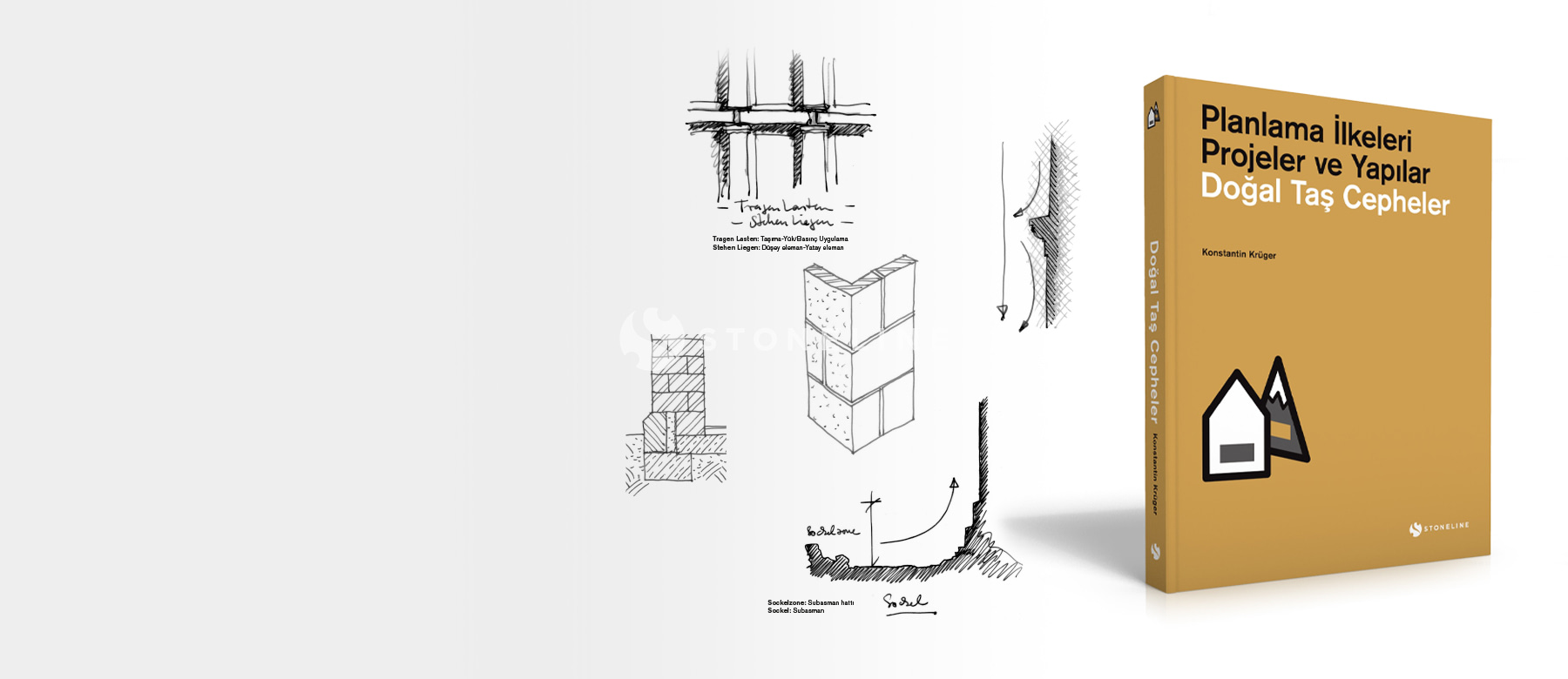
STONELINE PUBLICATIONS No: 1
Doğal Yaş Cepheler / Planlama İlkeleri – Projeler ve Yapılar
Author/Editor: Konstantin Krüger
Editor-in-Chief: Gülçin İpek
Translation from German to Turkish: Zuhal Nakay
Translation Proofreading and
Technical Advisor: Neslihan Güçmen
Translation Consultancy: Dr. Serkan Angı (Geological Engineer),
Sinan İzgi (Architect)
Art Director: Cem Günübek
Design: Masako Tomokiyo, Nicole Wolf
Cover Design: Mike Hermans
Publication Date: July 2022
Number of Pages: 304
Size: 22.5 x 28.0 cm
“Natural Stone Facades / Planning Principles – Projects and Structures” is the first book by STONELINE Publications, established by STONELINE Building Products, which has been serving the natural stone sector for 25 years.
Authored by Architect-Editor Konstantin Krüger, the book is enriched by texts from Philipp Meuser (Prof., Architect), Hermann Graser (President of the German Natural Stone Association), and Tobias Nöfer (Architect).
In the book, informative texts on theory and practice are presented alongside selected projects from international architectural firms, each meticulously reviewed by Konstantin Krüger, including detailed drawings, photographs, and texts explaining design principles. Out of the 23 projects chosen from 15 different cities, including Istanbul, Izmir, and Muğla, projects from five Turkish architectural offices (EAA-Emre Arolat Architecture, Atelier Han Tümertekin, Erginoğlu&Çalışlar, Teğet Architecture, DDA-Dilekci Architecture) are also featured.
“Natural Stone Facades” aims to both showcase the diverse applications of natural stone as a material and to provide guidance on its correct and effective use. It also highlights the importance of collaboration between investors (clients), architects, and stone suppliers, especially in the early stages of planning, aiming to simplify this process.
The book consists of five main sections that cover the current design trends and technologies in facade design with natural stone, references from architectural history, basic information, design methods, a comprehensive and unique examination of built structures and facades, the journey of natural stone from quarry to building, and an introductory classification of the main stone types.
These sections are:
Introduction and New Trends: Hermann Graser takes readers on a tour from the current advantages of natural stone as a building material to today’s applications, from traditional construction techniques to contemporary methods.
Theory and Basics: Considering the use of natural stone for ages Philipp Meuser questions whether contemporary architecture should sever its ties with this traditional material, concluding that it shouldn’t.
Designing with Natural Stone: Tobias Nöfer closely examines details like cornices, pilasters, columns, decorations, surfaces, corners, and joints. Structures and Facades: This section features projects built in the last 20 years as well as additional structures, renovations, repairs, and reconstructions.
Buildings and Facades: In this section, in addition to the projects built in the last 20 years, additional structures, renovations, repairs and reconstructions are also included. The project range, which extends from two-storey houses with gable roofs to multi-storey residences, includes different typologies such as residences, offices, hotels, schools and museums built with the reinforced concrete frame building system. In the selected projects, different façade types such as front wall, ventilated natural stone clad facade or self-supporting solid elements are exemplified. While each project is introduced in outline, from almost urban planning scale to joint detail, through texts, photographs and photo captions, the relationship between design and material is also examined. The projects are examined in terms of design approaches, by classifying them as those that have a relief effect, an emphasis on massiveness, an impressive position in terms of scale and positioning when viewed from a distance, and projects that stand out with their unique relationships with the environment and their use of light and shadow effects.
Extraction and Processing of Natural Stone and its Types: In the final section, Graser and Krüger explain the processes natural stone undergoes from quarry to cladding and describe the main types of natural stone.
The book, written in a language even non-architect readers can easily understand, is accompanied by nearly 1,000 photographs and technicaldetail drawings. Although its primarily focus is on the use of natural stone on facades, the book thoroughly informs the reader about natural stone.

